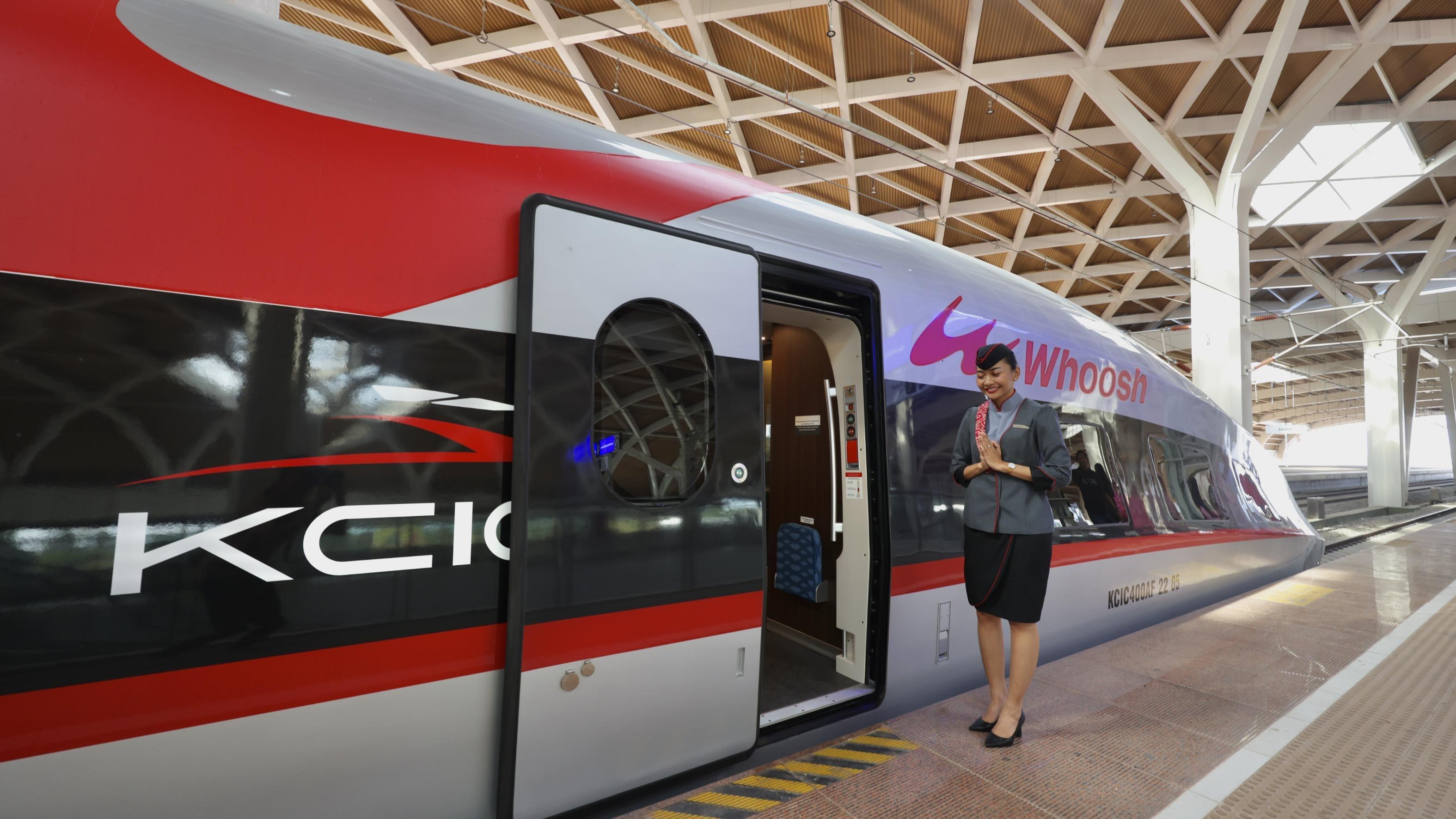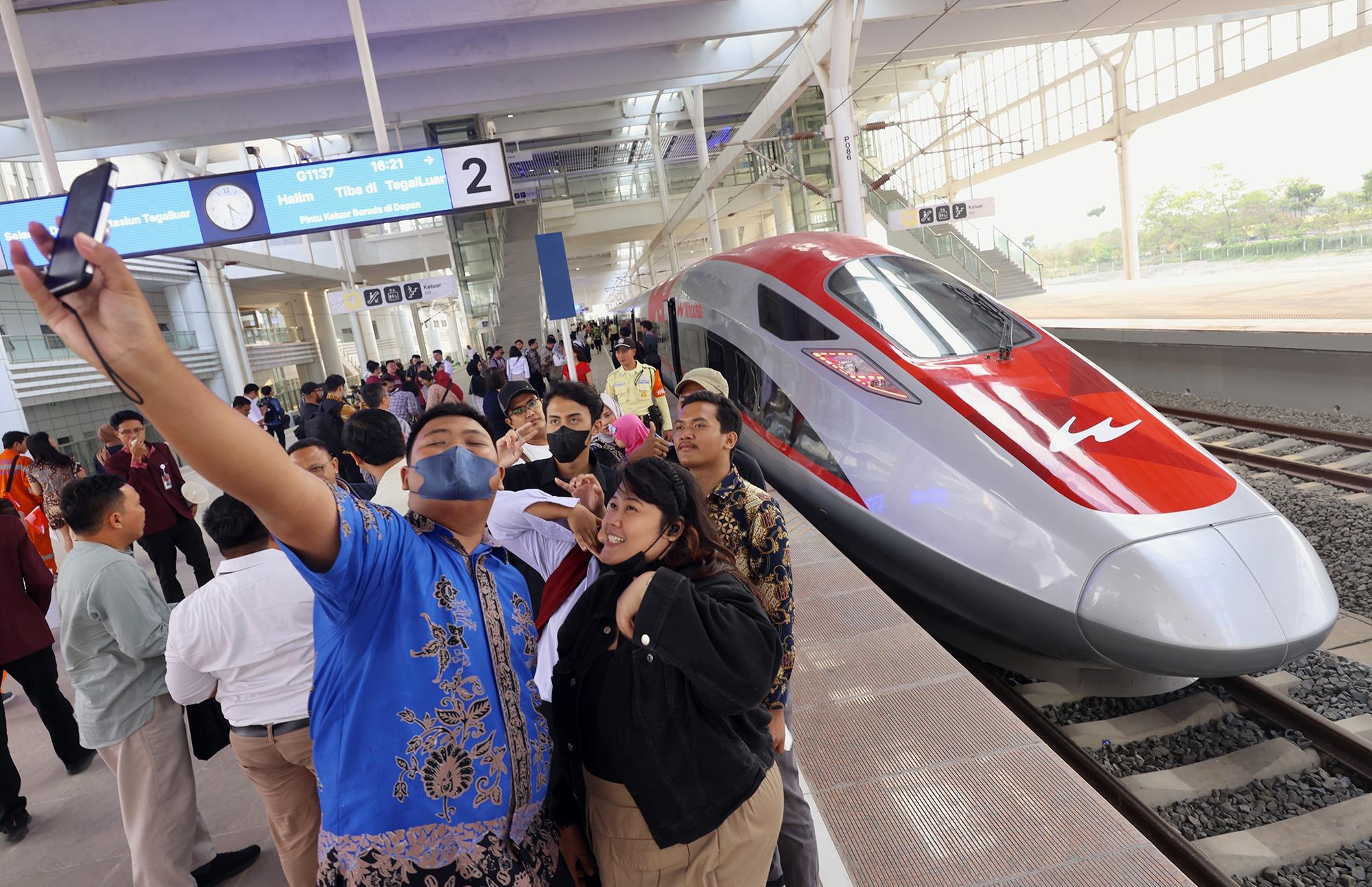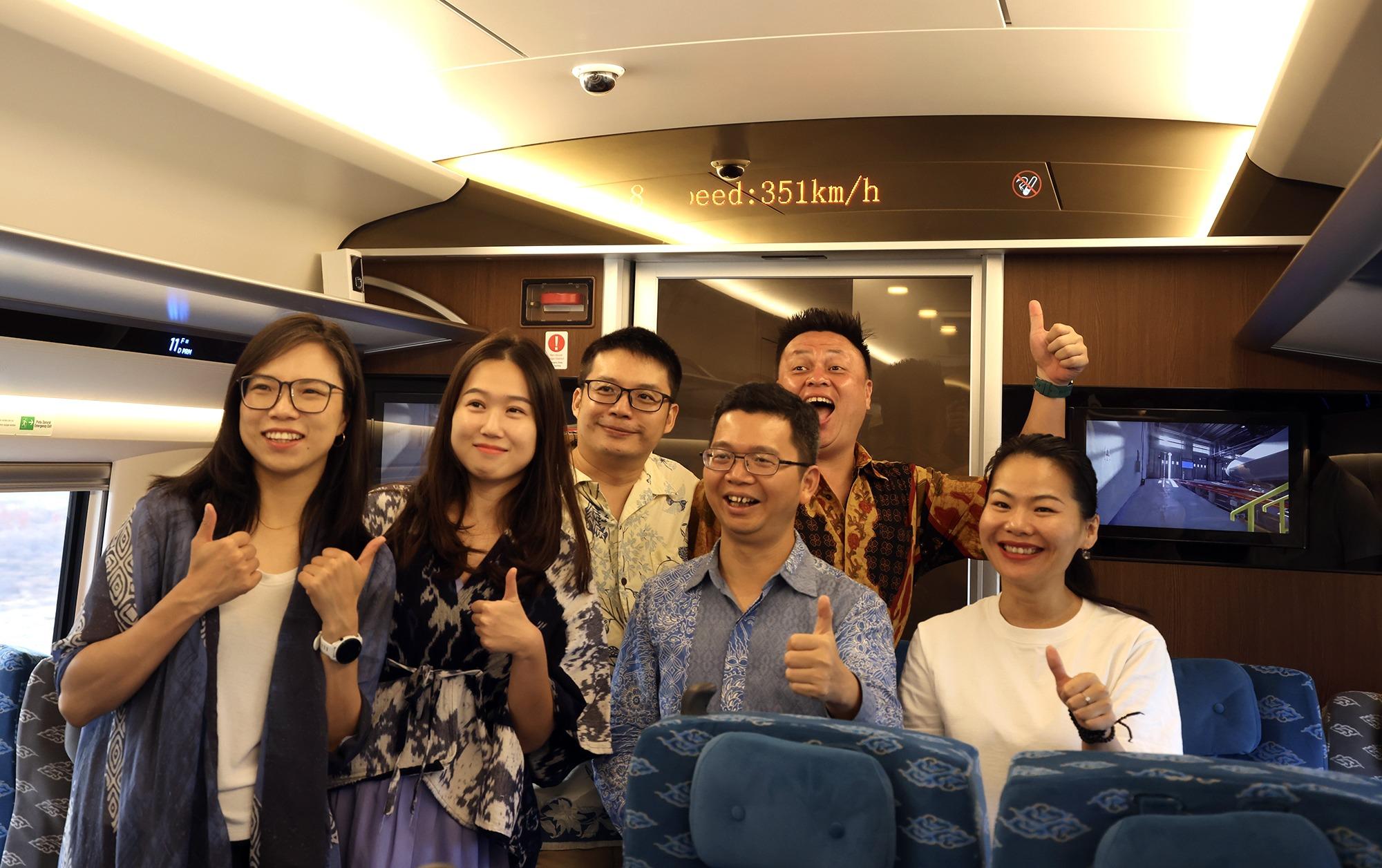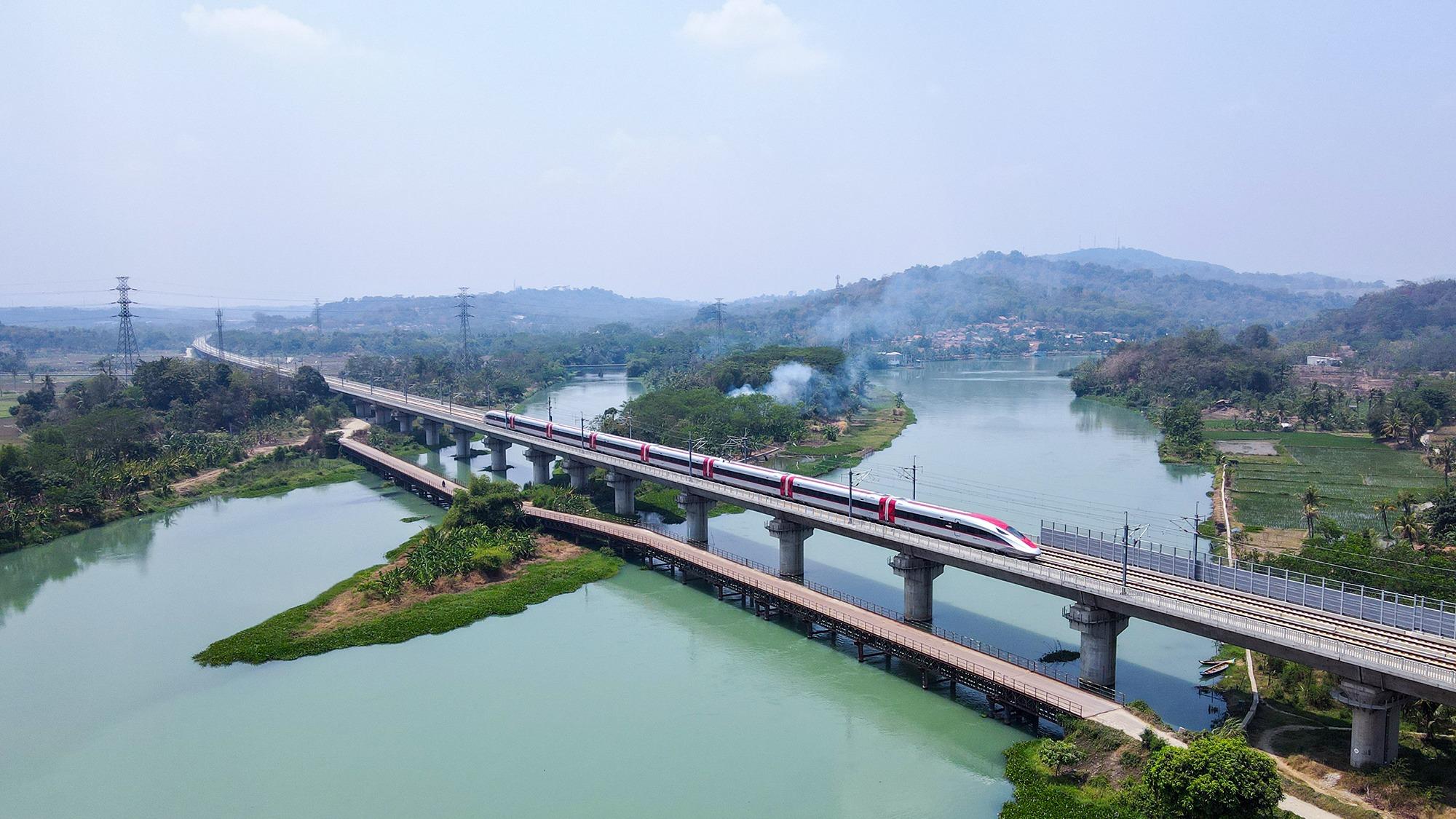Landmark Belt and Road project brings many benefits
 A high-speed train waits to leave the station in Jakarta. (EDMOND TANG / CHINA DAILY)
A high-speed train waits to leave the station in Jakarta. (EDMOND TANG / CHINA DAILY)
Ali Mustofa followed his Chinese instructor's guidance as he sat at the controls and tried to start a simulated high-speed train for the first time.
Undergoing training at the Bandung bullet train depot in Indonesia, Mustofa entered the train number and his driver ID details on the screen, watched carefully by his instructor, Mu Zhen.
"Keeping your fingers upright will help you avoid touching anything unintentionally," Mu said.
From inception to completion, and despite the challenges faced during the construction period, teams from both countries cooperated closely, supporting each other through difficulties and challenges.
Lu Kang, China’s ambassador to Indonesia
Mustofa then pushed a lever on the simulated device to display scenery on the large screen in front of him, with the scenery receding as the train pulled away. He continued pressing the lever to control the speed.
As the train accelerated, he read out, "45 kilometers per hour, 80 kilometers per hour, 150 kilometers per hour." As the maximum speed of 350 km/h was reached, he said, "That's fast!"
Mu told him, "You may feel dizzy the first time, but don't worry, you'll get used to it."
The simulator Mustofa is training on, which is being used to instruct the first-ever group of high-speed train drivers in Indonesia, was built by China, with the related scenery reproduced on a scale of 1:1.
The Jakarta-Bandung High-Speed Railway, or HSR, a landmark project that is part of the Belt and Road Initiative, or BRI, was built with Chinese technology. It has a total length of 142.3 km, linking Jakarta, the Indonesian capital, with Bandung in West Java province.
It is Southeast Asia's first high-speed rail service. The line's maximum speed of 350 km/h contrasts sharply with the previous highest railway speed in Indonesia of 120 km/h.
 Passengers take the first commercial ride on the Jakarta-Bandung high-speed line in Indonesia. (EDMOND TANG / CHINA DAILY)
Passengers take the first commercial ride on the Jakarta-Bandung high-speed line in Indonesia. (EDMOND TANG / CHINA DAILY)
Indonesian President Joko Widodo inaugurated the line on Oct 2, and it began commercial operation on Oct 17.
Chinese officials plan to transfer the technology to Indonesia to enable the nation to independently operate a high-speed railway system in coming years. To achieve this goal, China has trained more than 45,000 Indonesian personnel, including Mustofa.
Having worked as a train driver for more than 10 years, Mustofa was selected last year to take part in the Jakarta-Bandung HSR training program. He completed six months' theoretical training and successfully passed a written examination.
In the coming months, he is due to receive practical supervision from an experienced Chinese instructor. On completing his comprehensive training, Mustofa will be fully equipped to become one of Indonesia's first high-speed train drivers.
Born to a family with a long history of working in the railway industry, he is extremely proud that his father was a train driver. Mustofa said that during his childhood, trains driven by his father halted at all stops on a line, giving him the opportunity to board at leisure.
Discussing his theoretical training, Mustofa said the initial hurdle he faced was the language barrier.
 Passengers take the first commercial ride on the Jakarta-Bandung high-speed line in Indonesia. (EDMOND TANG / CHINA DAILY / XINHUA)
Passengers take the first commercial ride on the Jakarta-Bandung high-speed line in Indonesia. (EDMOND TANG / CHINA DAILY / XINHUA)
In late February, he was part of a group of personnel undergoing training for the Jakarta-Bandung HSR in a program conducted by Chinese railway institutions. The training was given online to the Indonesian team, and a translator was used for each session to get around the language barrier.
Mustofa familiarized himself with the train's electric power system for the first time, which posed a considerable challenge. Most trains in Indonesia are powered by internal combustion engines. In contrast, high-speed trains use electricity to achieve their rapid operational speeds.
"The Chinese instructors are extremely patient. They slow down to explain concepts until we understand them," Mustofa said.
Mu, his Chinese instructor, is a high-speed train driver with eight years' experience. Mu traveled to Indonesia in October last year to take part in the trial operation of the Jakarta-Bandung HSR. His current task is to assist Indonesian train drivers such as Mustofa.
"The language barrier and a lack of sources of electricity are not a problem. It will all be fine," Mu said.
 Passengers take the first commercial ride on the Jakarta-Bandung high-speed line in Indonesia. (EDMOND TANG / CHINA DAILY / XINHUA)
Passengers take the first commercial ride on the Jakarta-Bandung high-speed line in Indonesia. (EDMOND TANG / CHINA DAILY / XINHUA)
Standout feature
The Jakarta-Bandung HSR project is the first overseas venture to rely wholly on Chinese railway systems, technology and components.
Ju Guojiang, chairman of China Railway International Co, said: "The project's main feature is undoubtedly its speed. It is the first high-speed railway built outside of China to have a top speed of 350 kilometers per hour."
The China-Laos Railway was designed with a maximum speed of 160 km/h, while the Hungary-Serbia Railway, which is still under construction, has a projected top speed of 200 km/h.
The Jakarta-Bandung HSR is the result of joint efforts by participants from China and Indonesia. The two nations signed an agreement in October 2015 to establish a joint venture to build and operate the project, for which construction began in 2018.
Dwiyana Slamet Riyadi, president-director of PT Kereta Cepat Indonesia China, or KCIC, said, "We worked together on construction, operation and maintenance."
KCIC is a joint venture between PT Pilar Sinergi BUMN, a consortium of Indonesian government-owned companies, and Beijing Yawan Co, a syndicate of Chinese railway companies.
 Passengers take the first commercial ride on the Jakarta-Bandung high-speed line in Indonesia. (EDMOND TANG / CHINA DAILY / XINHUA)
Passengers take the first commercial ride on the Jakarta-Bandung high-speed line in Indonesia. (EDMOND TANG / CHINA DAILY / XINHUA)
Riyadi said most of the construction workers for the project were Indonesian, with 15,000 people employed. There were seven Indonesian workers for every Chinese employee.
The Jakarta-Bandung high-speed line boasts 13 tunnels and 56 bridges. The trains, which have been adapted for Indonesia's tropical climate, are equipped with a safety system that responds to earthquakes, floods and other emergency situations.
Lu Kang, China's ambassador to Indonesia, said, "This high-speed railway project is a very fine example of the mutual trust and mutual assistance among friendly countries.
"From inception to completion, and despite the challenges faced during the construction period, teams from both countries cooperated closely, supporting each other through difficulties and challenges."
In the coming years, Indonesia is expected to become fully equipped to operate the new high-speed line independently.
Riyadi said: "We foresee a smooth transfer of technology and knowledge. We expect this process to take one to two years."
 A train operating on the Jakarta-Bandung high-speed line crosses a river in Purwakarta, Indonesia, on Oct 11. The line, which was inaugurated on Oct 2, began commercial operation on Oct 17, 2023. (PHOTO / XINHUA)
A train operating on the Jakarta-Bandung high-speed line crosses a river in Purwakarta, Indonesia, on Oct 11. The line, which was inaugurated on Oct 2, began commercial operation on Oct 17, 2023. (PHOTO / XINHUA)
Travel time cut
China has liaised with nations and regions involved in the Belt and Road Initiative, aiming to use its experience and technology to support the development of more countries. However, the motives behind China's actions have been questioned by some international commentators.
Responding to these concerns, Riyadi said, "We will benefit from this project, particularly in terms of economic and regional growth, as well as later, when the high-speed route has been operational for some time."
Connecting Jakarta with Bandung, the heavily populated capital of West Java, the high-speed line serves a population of 40 million, drastically reducing travel time between the two cities from more than three hours to just 40 minutes.
The World Bank has said that implementing all the projects within the BRI framework will generate about $1.6 trillion in global revenue annually by 2030. This would account for 1.3 percent of global GDP, with 90 percent of the benefits shared among participating partners.
Lu said, "From 2015 to 2030, almost 40 million people will be lifted out of poverty under the auspices of the BRI."
The new line's high operating speed of 350 km/h is motivating Mustofa, the driver, to study high-speed rail technology.
"As I am responsible for the safety of passengers traveling at such a speed, I feel a great deal of pressure," Mustofa said.
This responsibility is inspiring Mu, Mustofa's instructor, to instill a sense of awe in his pupil.
"When I was a trainee, my instructor told me to regard high-speed trains with a sense of awe so that I could concentrate on my work and transport passengers safely. I hope Mustofa can develop this sense of awe. It is the most important thing I want to pass on to him," Mu said.
Mustofa hopes to fully master the technology for driving bullet trains in the next few months to make his mark on history as one of his country's first high-speed train drivers.


